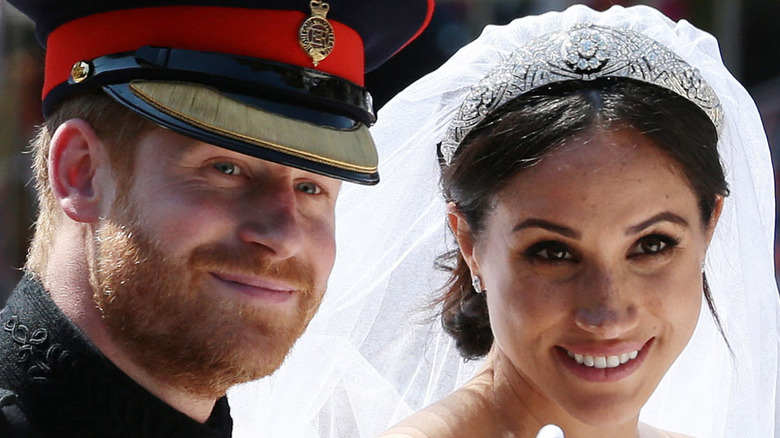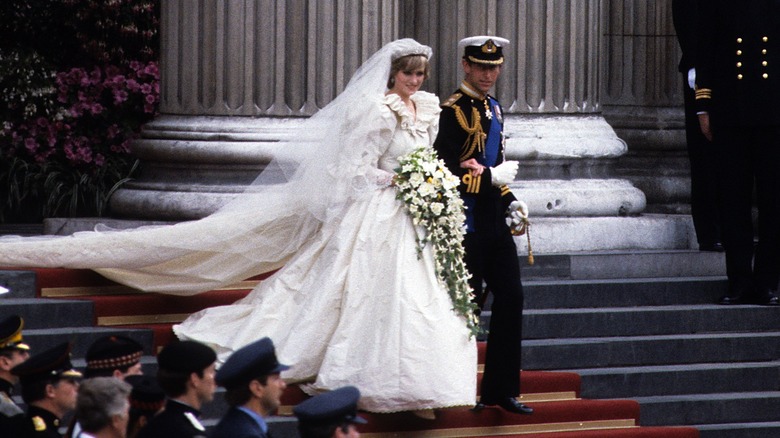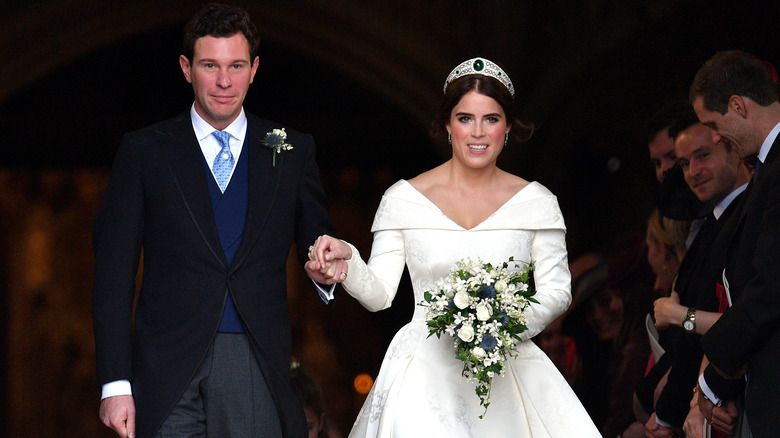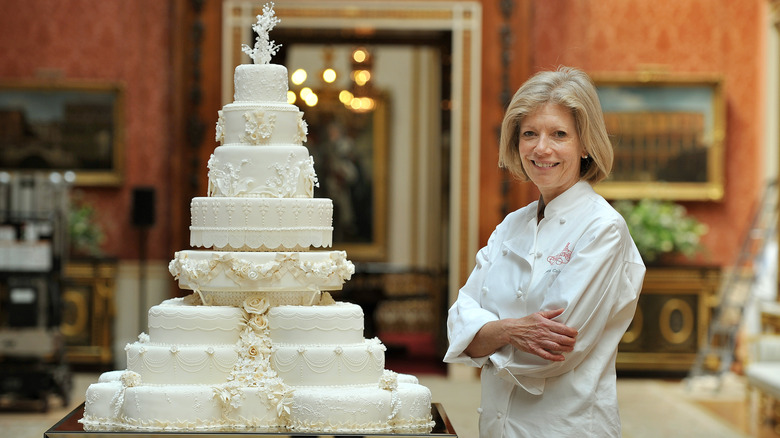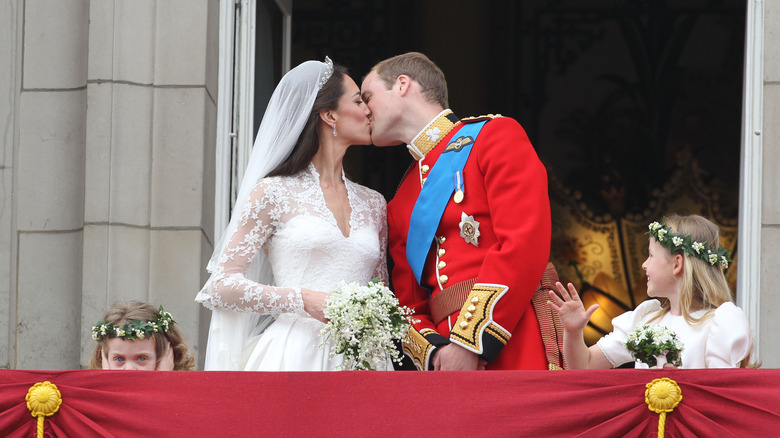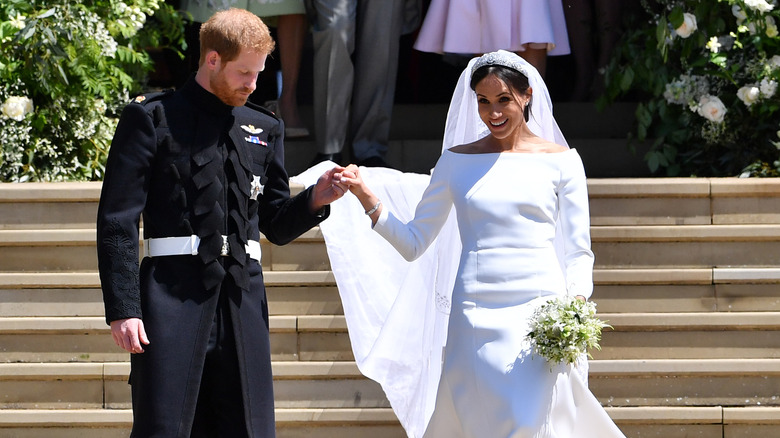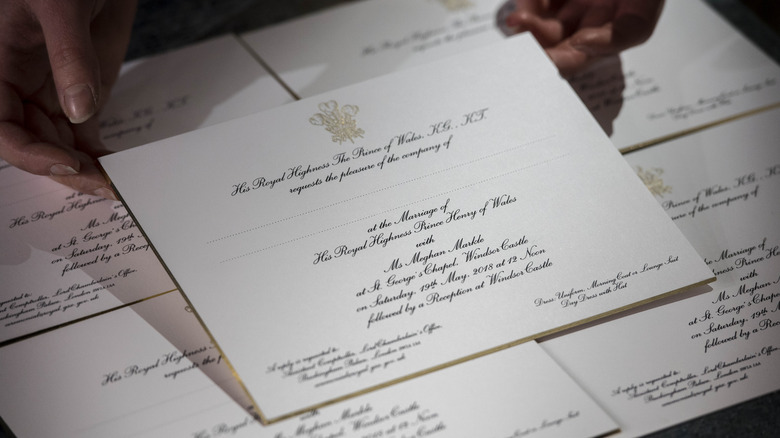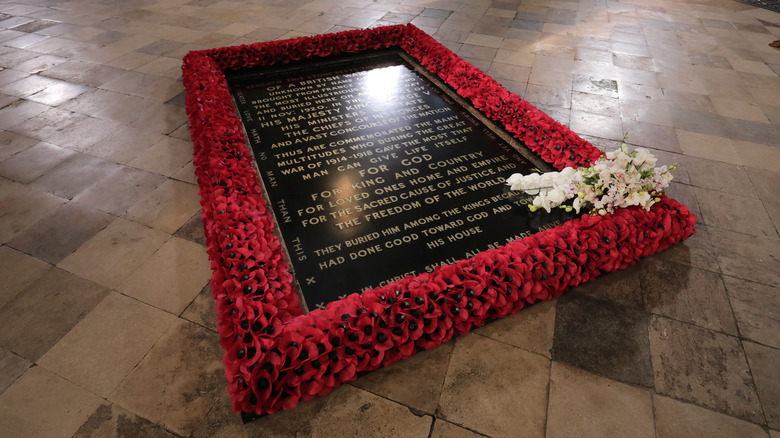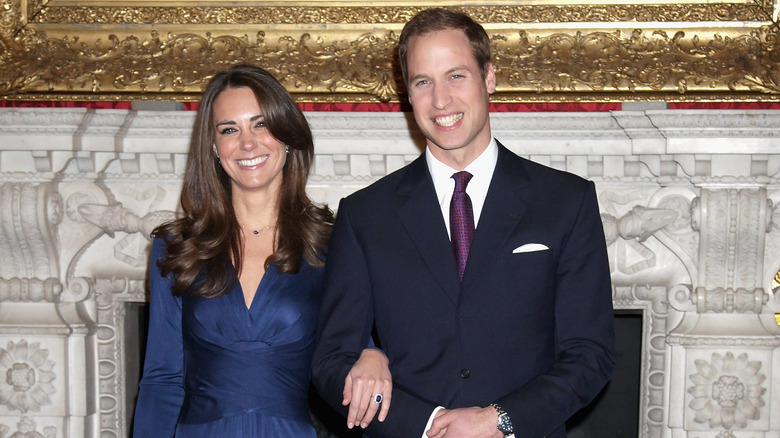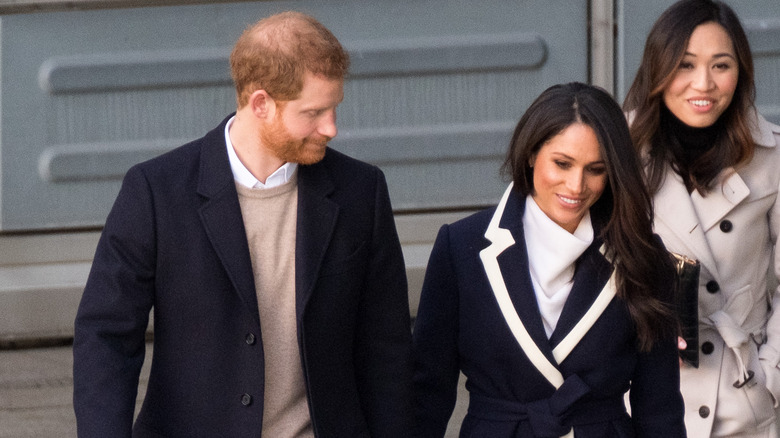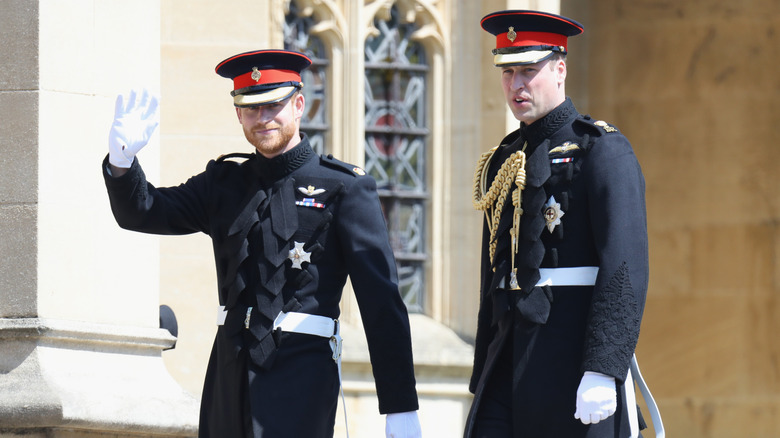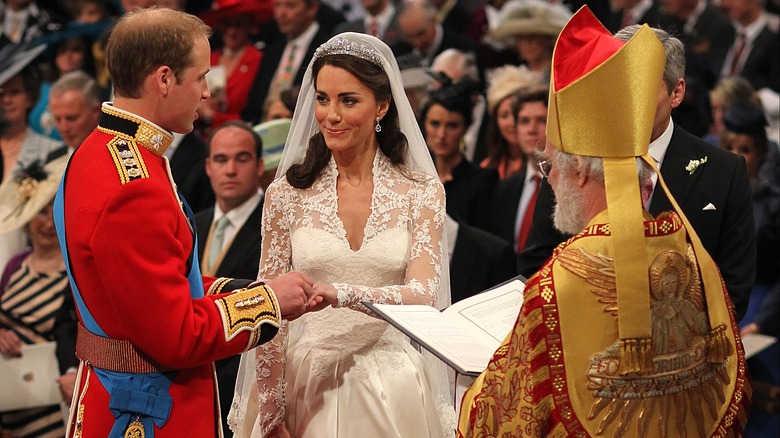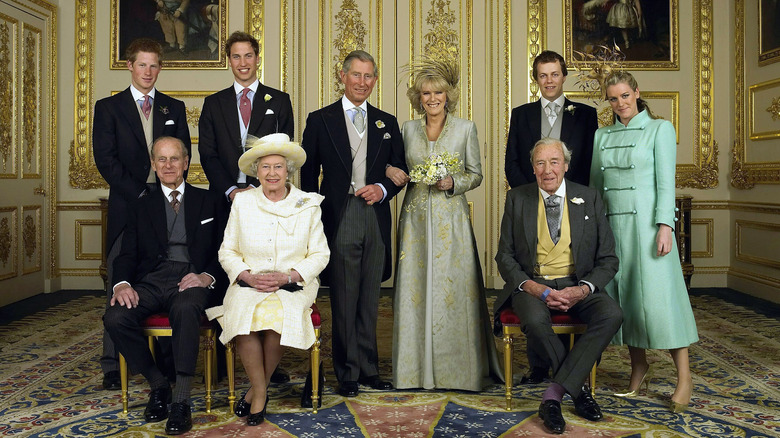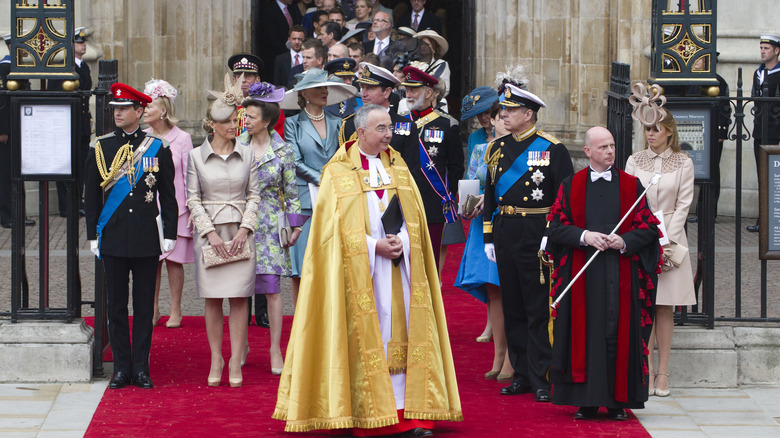Things Royals Can't Do At Their Weddings
To outsiders, a royal wedding is the ultimate fairy tale celebration, an event filled with glamour and beloved members of the monarchy. These extravagant affairs draw plenty of attention right from the start. There's the exciting engagement announcement, invitations fit for a queen, and plenty of wedding prep. Then, of course, there's the fashion. After all, everyone, including the guests, must look their very best for the special day, which means it won't just be the wedding party decked out in stunning ensembles. From the gorgeous wedding dress to a cake that looks like a work of art, any royal wedding should appear to be every commoner's dream come true.
Still, while the everyday couple might be fascinated with the opulence of these royal nuptials, not every aspect of these weddings is a piece of cake. For royals, their special day isn't just about saying "I do" — there's also plenty of age-old rules the couples are expected to follow. Some of these expectations might seem relatively simple and even charming, like putting a sprig of myrtle in a bride's bouquet. However, others, such as the long list of requirements a wedding dress must meet, could easily have the bride-to-be frustrated at the lack of choice for her bridal outfit. One thing's for sure: Royal weddings are breathtakingly beautiful, but, for the participating royals, a historically significant affair also means consenting to numerous royal wedding traditions and rules. Read on to learn the things royals can't do at their weddings.
A royal bride cannot wear a colorful wedding dress
Picking out the perfect wedding dress is the dream of every bride-to-be. While many already have an idea of what they do or don't want for their attire, this important decision isn't solely up to the wife-to-be if she's having a royal wedding. If you're going to be a royal bride, your bridal outfit must comply with precise formal requirements. According to CBS News, tradition will expect the lovely lady to wear a somewhat modest dress. Usually, this means the bride's gown will have some kind of sleeves like Kate Middleton's lace ones (one of the most expensive and best fashion moments) or Princess Diana's statement-making version. In keeping with the modest theme, another no-no is bearing cleavage.
Perhaps unsurprisingly, the bride is also expected to wear white. According to WWD, this royal trend was started by none other than Queen Victoria. Prior to the queen's stunning white court dress, royal brides typically got decked out in colorful garments, but Victoria's wedding in 1840 to Prince Albert rang in a new style for all future royal brides. But, of course, these are not the only rules the soon-to-be royal Mrs. must follow. According to Cosmopolitan, a wedding dress fit for royalty should be created by a British designer, and, naturally, should be accessorized accordingly with an eye-catching tiara. Finally, before the future bride can get dressed on her special day, she must first receive the queen's approval of the final look.
The royal bride cannot leave this herb out of her bouquet
Every bride wants a beautiful bouquet that not only complements her dress and decor but also makes its own stunning statement. But, of course, a member of the monarchy cannot have just any old bridal flowers for a royal wedding. According to the Daily Mail, a royal bride's lovely bouquet must contain a sprig of myrtle per tradition. This unique custom started in 1858 when Princess Victoria, daughter of Queen Victoria, added the herb to her bridal flowers. Initially, the myrtle was given as a gift to Queen Victoria by Prince Albert's grandmother and was later planted in the royal couple's vacation home, the Osborne House.
According to the Daily Mail, the myrtle currently used for modern royal brides comes from a bush derived from the original plant. Allegedly, this plant is said to be a symbol of luck and loyalty. To this day, many royal brides have followed this romantic tradition of including a sprig of myrtle in their bouquets. For example, the queen put her myrtle among white orchids, while the late Princess Diana surrounded her sprig with white and gold stephanotis, gardenias, and orchids. Kate Middleton placed hers alongside sweet William, lily of the valley, and hyacinth. Lastly, Meghan Markle stuck with tradition by arranging myrtle among one of Diana's favorite flowers, Forget-Me-Nots (via Town & Country). Markle's flowers also included sweet peas, lily of the valley, and jasmine.
Royals don't usually choose just any old wedding cake
If you're going to have a royal wedding, you can't just choose any old cake. No, when it comes to this particular dessert, the more decadent, the better. According to custom, fruitcake has been the go-to flavor for royal weddings for centuries (via Vogue). While fruitcake often gets a bad rap, this fruity liquor-soaked dessert has been considered perfect for special occasions, including weddings, since the Middle Ages. One of its claims to fame is its supposed long-lasting pre-refrigeration. Additionally, the "dried fruits, alcohol, and spices" in this unique dessert are meant to symbolize prosperity, the perfect complement for a royal celebration.
Still, the flavor isn't the only must for a royal wedding cake — history shows that bigger is also considered better (via the Food Network). For example, Queen Elizabeth II had a traditional fruitcake wedding cake that stood an impressive 9 feet tall and weighed about 500 pounds. Similarly, Princess Grace's six-tier wedding cake stunned guests with an extravagant display of turtledoves that were released from one of the tiers after Prince Rainier III's sword cut through the cake. While tradition is still the preferred choice, these rules aren't a be-all-end-all, as plenty of modern royals have chosen to opt-out of certain traditional elements. For example, Prince Harry and Meghan Markle broke away from the traditional fruitcake and instead went with a sponge cake with elderflower syrup (via Twitter).
Royals don't often skip the special balcony kiss
If there's one thing the monarchy loves when it comes to weddings, it's tradition, and this custom definitely appeals to a royal's inner romantic. According to Britain Magazine, having the royal bridal party appear on the balcony at Buckingham Palace is a special tradition that began with Queen Victoria and Prince Philip in 1840. From there, newlywed royal couples continued the practice, with the Queen Mother appearing in 1923 and Queen Victoria and Prince Philip appearing in 1947. However, a new ritual started in 1981 when Prince Charles and Princess Diana shared a kiss on the balcony. This memorable custom created a new standard for royal newlyweds.
Since the first iconic balcony kiss, other royal couples, like Prince Andrew and Sarah Ferguson, have followed suit. In the documentary series "Finding Sarah: From Royalty to the Real World," Ferguson memorably tells Oprah Winfrey, "Everyone told us not to kiss on the balcony, so we did it deliberately" (via Express), adding, "We both were so in love." Likewise, according to Southern Living, Princess Diana's son Prince William also famously followed in his mother's footsteps, sharing the iconic kiss with his new bride, Kate Middleton (who also had rules to follow after marrying William). On the other hand, Prince Harry, who wed Meghan Markle in London at Windsor Castle, didn't have a balcony moment, as they weren't near Buckingham Palace. The couple instead shared a special public kiss right outside the church.
The royal groom can't wear a tux
While at the average wedding the groom typically dresses in a well-fitted tuxedo or suit, a royal husband-to-be won't be seen in the standard outfit. Traditionally, a royal groom wears military regalia instead. According to Bustle, this custom isn't just because the soon-to-be-married royal was involved in the service. No, these ensembles are also worn because certain members of the monarchy have honorary military titles given to them by the queen.
Recent royal grooms to continue this practice include Prince William. He followed the custom but surprised guests by wearing a red Irish Guards outfit instead of a Royal Air Force uniform (via Time). This choice was unexpected, since the Duke of Cambridge served in the RAF but, instead, chose to observe his honorary rank of Colonel of the Irish Guards.
Similarly, E! News commented on Prince Harry's time-honored wedding wear, saying that the groom wore a decorated dark blue captain's uniform tailored by Dege & Skinner. The outlet also commented on his trimmed beard, which was a surprising addition. As pointed out in an article from the Independent before the Duke of Sussex's wedding, his facial hair was unexpected, as military tradition doesn't permit the British Army to have beards. The outlet additionally mentions a since-deleted article by the Press Association in which historian Hugo Vickers said it would be unlikely for Harry to wear his uniform without being clean-shaven, though he did admit the royal "does it sometimes" against advice.
Royals can't use your average wedding invitations
If you're planning a royal wedding, you can't pick out just any invitations, of course. Traditionally, royal wedding invites are crafted by an esteemed company like Barnard & Westwood. As Daily Mail reporter Rebecca English stated via Twitter, "The company [Barnard & Westwood] has held a Royal Warrant for Printing & Bookbinding by Appointment to Her Majesty The Queen since 1985." She added that they received a second royal warrant for printing in 2012 by the Prince of Wales. As Town & Country noted, another highly-regarded establishment is Smythson, a British brand that currently has three royal warrants.
Other standard protocols include listing the royal participant first on the invitations. According to Smythson manager Ruth Baxter, this explains why Prince Harry's name appears before Meghan Markle's on their wedding invitations (just one rule Meghan had to follow). "Royal wedding invitations follow royal protocols above general wedding etiquette so the royal participant will always be named first on the invitation — for non-royal weddings the bride is traditionally named first but, as Her Majesty, The Queen's grandson, HRH Prince Harry will be named first," she said (via Town & Country). Additionally, Baxter said the royal family prefers the use of the word "with" instead of "to" between the bride and groom's names, as this appeals to modern couples — since the word "with" gives a better sense of equality between the joining parties than "to." One thing's for sure: Royal invites always look stunning.
A royal bride cannot toss her bouquet
A royal bride should hold on tight to her bouquet. According to Westminster Abbey's website, tradition states that the bridal flowers be placed on the tomb of the Unknown Warrior in Westminster Abbey as a military tribute. This practice of honoring those who served first started with the Queen Mother, who placed her bouquet on the Unknown Warrior's grave in recognition of her late brother Fergus, who died in 1915 at the Battle of Loos. The grave of the Unknown Warrior contains the remains of an unidentified British serviceman whose body was brought from Northern France and buried on November 11, 1920. This man is meant to represent all the fallen members of the British military who died during World War I and whose bodies remain undiscovered or unidentified.
Hello! states that popular royals, such as Kate Middleton, Meghan Markle, Princess Beatrice, and Princess Eugenie, have continued this custom. On Remembrance Sunday in 2020, Beatrice shared a photo to Twitter of her wedding bouquet placed on the Unknown Warrior's tomb. She captioned the image, "Today we remember and honour all those who sacrificed so much for us. We shall never forget!" Similarly, Eugenie also shared a homage in a since-deleted Instagram story (shared via Express) where she reflected on the significance of the grave and service members. "As with tradition, my wedding bouquet was laid on there," she added.
Royals can't get married without the queen's permission
Forget eloping. Depending on where a royal stands in line to the throne, they might require the queen's approval just to get married. Although, according to BBC News, these royal rules have loosened up a bit in recent years. The media outlet announced in 2015 that the Succession to the Crown Act, which replaced the Royal Marriages Act of 1772, changed the law so that only the first six in line to inherit the throne need the queen's approval to get married. But, of course, for those six, the new law doesn't change anything in terms of requiring permission.
Simply glancing at one of the super formal multi-page letters of endorsement that the queen gave for Prince Harry and Meghan Markle's wedding (via Twitter) indicates this protocol isn't one to take lightly. The queen's original blessing was just as formal, albeit a bit more personal. She wrote, "My Lords, I declare My Consent to a Contract of Matrimony between My Most Dearly Beloved Grandson Prince Henry Charles Albert David of Wales and Rachel Meghan Markle, which Consent I am causing to be signified under the Great Seal and to be entered in the Books of the Privy Council" (provided via Sky News). Though she refers to her grandson as "beloved," the pressure of getting Her Majesty's approval is certainly one thing that everyday couples are surely glad they can skip.
Royals are discouraged from marrying Roman Catholics
There are plenty of issues for a couple to discuss before they get married. If that couple also happens to be royal, the subject of religion might be a bit touchy. For a long time, the 1701 Act of Settlement prohibited royals from marrying Roman Catholics, stating that no Roman Catholic or anyone married to one could inherit the throne. Of course, since then, the law has changed thanks to new rules. However, there are still some exceptions that royals must take into account. For example, even though a royal can marry a Roman Catholic and become a ruler, a Roman Catholic royal cannot inherit the throne.
Additionally, we should note that, although the law has been adjusted, being a member of the Church of England is still a clear preference, as evident in Meghan Markle's decision to have a private baptism. According to the Daily Mail, the Duchess of Sussex underwent the secret ceremony before her wedding as a sign of respect. After all, the queen is the head of the Church of England. The outlet also mentions that the former actress had a multi-faith upbringing and attended a Roman Catholic high school, though she was not Catholic herself. Regardless, the intimate ceremony only goes to show that tradition matters when it comes to royalty.
A royal groom typically won't have a best man
Tradition states that you aren't meant to have a best man if you're an engaged royal. According to royal expert Marlene Koenig via Town & Country, the words "best man" aren't exactly typical of a royal wedding. "The best man or best men are officially called supporters," says Koenig. According to Hello!, this custom was followed by Prince Charles who chose his brothers, Prince Andrew and Prince Edward, as his supporters when he married Princess Diana. Similarly, Edward also had his brothers as his supporters on his own wedding day.
However, Prince William broke tradition by having his brother, Prince Harry, as his best man at his wedding to Kate Middleton. The aforementioned outlet states that the Duke of Cambridge's choice of terminology felt more authentic to his situation than the customary term. Similarly, Harry followed suit and asked his brother to be his best man at his wedding to Meghan Markle. Kensington Palace confirmed the Duke of Sussex's news via Twitter. Additionally, the thread included a follow-up statement declaring that William was "honoured to have been asked, and is very much looking forward to supporting his brother."
Royal wedding rings must contain this rare gold
When it comes to royal weddings, like the cake and the invitations, the ring must also be quite specific. According to Clogau, the tradition of British royals using the rare and highly prized Welsh gold for wedding rings began in 1923 with the Queen Mother. From there, this extravagant custom continued with Queen Elizabeth II's marriage to Prince Philip in 1947, Prince Margaret's marriage in 1960, Prince Charles' marriage to Princess Diana in 1981, and Prince Charles' second marriage to Camilla Parker Bowles in 2005.
According to BBC News, Prince William and Kate Middleton similarly followed this glamorous practice. The news source reiterated a statement from the palace, revealing that Kate's wedding ring would, indeed, be made of Welsh gold. The news outlet added that the ring was given to the Duke of Cambridge by his grandmother, the queen, shortly after the couple's engagement. As for William's brother, Prince Harry, he and Meghan Markle also accessorized in style, with Kensington Palace confirming the news via Twitter. The announcement stated that rings for the couple would be crafted by Cleave and Company, with a follow-up adding, "Ms. Markle's ring has been fashioned from a piece of Welsh Gold, gifted by Her Majesty The Queen." Wearing luxury wedding rings is one rule that royals clearly love to follow.
The royal couple cannot shy away from official photos
When it comes to royal weddings, the lucky couple better not be camera shy. It's a tradition that the newlyweds pose for an official portrait shortly after the wedding ceremony. According to Brides, the first official royal wedding photo happened back in 1863 with King Edward VII and Queen Alexandra (who, at the time, were known as the Prince and Princess of Wales). Since then, this practice has continued for over a century.
A 2018 article from Town & Country noted the similarities and differences of the wedding images for popular royal brothers Prince William and Prince Harry, both of whom naturally continued this time-honored trend. Hugo Burnand photographed William and Kate Middleton's wedding portraits, which were taken in Buckingham Palace's Throne Room, while, in contrast, Alexi Lubomirski took Harry and Meghan Markle's wedding pictures in Windsor Castle's Green Drawing Room. Though both couples posed for a couple's portrait, a bridesmaids and page boys' picture, and a big family photo, the article notes that the Duke and Duchess of Sussex's couple's shot is much less formal than the other newlyweds' images.
A royal wedding cannot just happen anywhere
Location definitely matters where royals weddings are concerned. While it isn't a hard-set rule, Westminster Abbey's website states that the tradition to have a royal wedding at the church is a custom that dates back to 1100, when Henry I married Princess Matilda of Scotland. Other royal couples who have exchanged vows at this iconic location include King George VI and Lady Elizabeth Bowes-Lyon in 1923, Princess Margaret in 1960, Princess Alexandra in 1934, Princess Anne (aka the Princess Royal) and Captain Mark Phillips in 1973, and Prince Andrew and Sarah Ferguson in 1986.
Westminster Abbey's website also notes the royal nuptials of Prince William and Kate Middleton, who wed at Westminster Abbey in 2011 — adding that their big day saw around 2,000 wedding guests filling the church. But, of course, Westminster Abbey isn't the only place worthy of a royal wedding. Prince Harry and Meghan Markle chose a different location, St. George's Chapel, situated on the grounds of Windsor Castle, a site that still holds plenty of rich royal history. Vogue states that St. George's has also seen its share of royal weddings, such as that of Prince Charles and Camilla Parker Bowles. However, it's also held many royal funerals as well. Regardless, choosing a venue for a royal wedding clearly means picking a location that contains plenty of historical significance.
